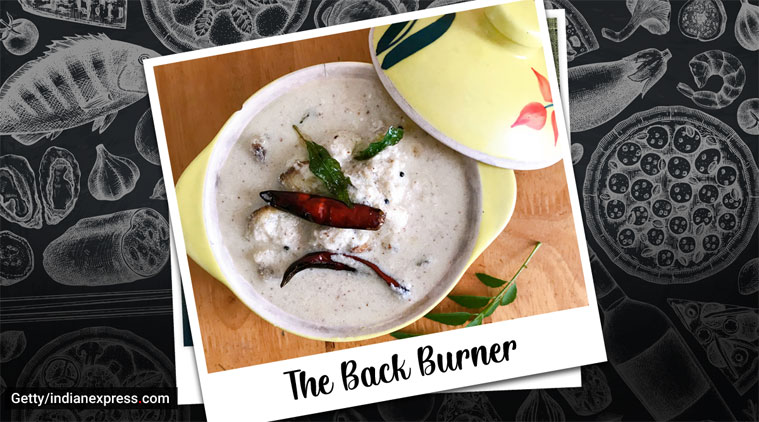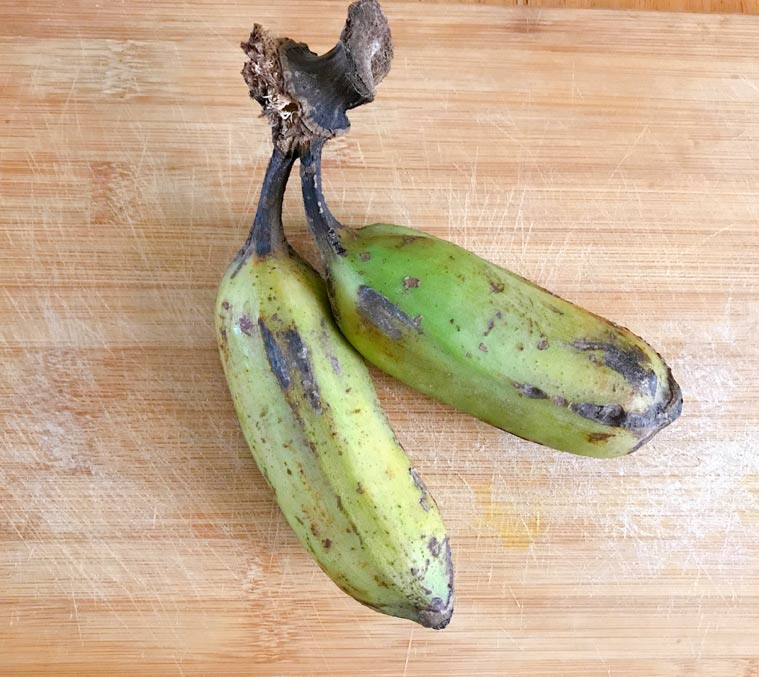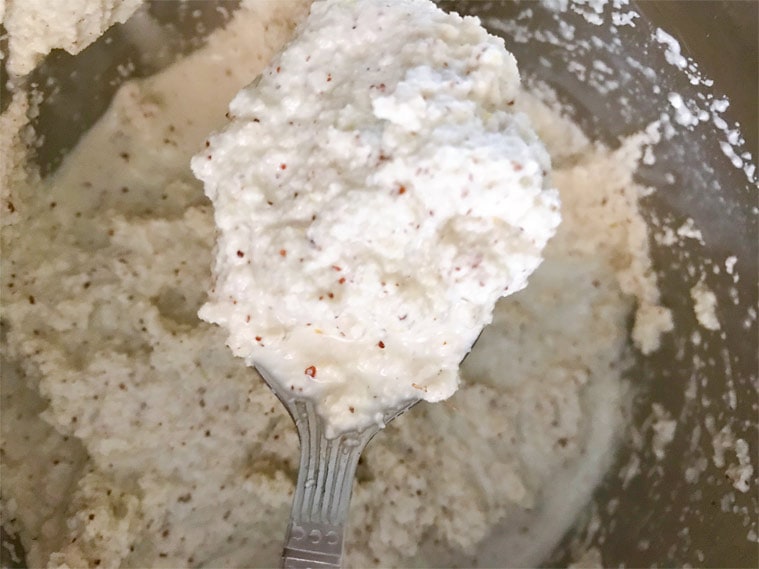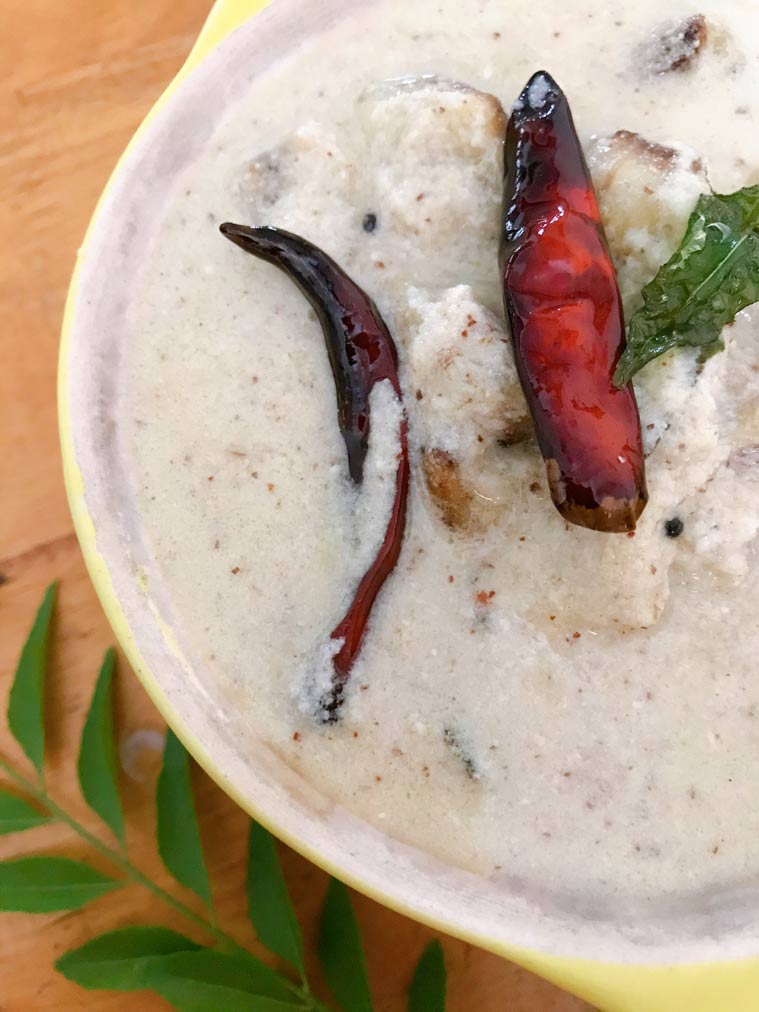 Serve vazhakka pachadi as a side with rice and sambar. (Photo: Pooja Pillai)
Serve vazhakka pachadi as a side with rice and sambar. (Photo: Pooja Pillai)
First, an apology: this post was to be out on Saturday, but due to a pet-related crisis in the household, I couldn’t write it. But now that the crisis is being handled, here is the latest post, this one on vazhakka (raw plantain) pachadi.
Pachadi is a mandatory part of the one Malayali culinary concept that most non-Malayalis are familiar with: the sadhya. It can be made using different vegetables — raw mango, bitter gourd, beetroot, ladies’ fingers — and fruits — ripe mango, pineapple, ripe plantain. Pineapple pachadi is, of course, the most popular; the sweetness and tartness of the fruit go fantastically well with the coconut and curd base of the dish. Except for the grating of the coconut, pachadi is quick, no-fuss and light: exactly what one needs when it’s the temperature is in the high 30s.
My personal favourite is the one made with ripe mango, but the bitter gourd pachadi comes a close second. In fact, I had originally planned to make pachadi with bitter gourd this week, but then I noticed that the raw plantains (vazhakka) I had bought were starting to ripen (summer heat) and needed to be used immediately.
 Vazhakka, or raw plantains, that are just starting to ripen will have a hint of sweetness that will greatly enhance the taste of the dish. (Source: Pooja Pillai)
Vazhakka, or raw plantains, that are just starting to ripen will have a hint of sweetness that will greatly enhance the taste of the dish. (Source: Pooja Pillai)
A quick note about what pachadi is: it’s a lightly cooked vegetable (or fruit) mixed with the fresh curd and a ground coconut paste. I suppose you could call raita a non-Malayali pachadi, although the latter, in my opinion, has a more complex flavour profile. This is mainly due to the use of ground mustard seeds. According to my mother, that’s where the name “pachadi” comes from: “pacha kadugu”, meaning “raw mustard seeds”, somehow became “pachadi”. I can’t guarantee that this is true, but that’s something for food historians to investigate.
In fact, it’s the mustard seeds that set pachadi apart from another very similar Malayali dish called kichadi (not “khichdi”). Both have the same vegetable-meets-coconut-and-curd mixture concept, but typically, ground mustard seeds find no place in kichadi. It’s all a little unclear, though because in The Essential Kerala Cookbook (Penguin Random House, 2003), Vijayan Kanampilly writes, “The differences between a pachadi and a kichadi are subtle in that the sequence of steps is different, and sometimes, the number of ingredients varies.” He follows this up with a bitter gourd kichadi recipe which uses raw mustard seeds ground with the coconut paste. Like I said, unclear.
Here’s the vazhakka pachadi recipe:
2 – Raw plantains (if they’re starting to ripen, then there will be a hint of sweetness which will make the pachadi even tastier)
1 cup – Fresh curd
½ – Coconut, grated
3-4 – Green chillies (increase or decrease the quantity depending on your tolerance and how potent the chillies are)
1 tsp – Mustard seeds
5-6 – Fresh curry leaves
2 – Dried red chillies
1 tbsp – Coconut oil (any neutral flavoured oil will do, if you don’t have coconut oil)
Salt, to taste
Peel and chop the plantains. In a wok, heat a little of the oil and saute the plantains on medium flame till they start to brown. Switch off the gas and set aside.
Grind the coconut with green chillies and half the mustard seeds to as fine a paste as possible. Add water, a little at a time, to get the right consistency.
 Grind the coconut with green chillies and mustard seeds, adding a little water at a time, to a very fine paste. (Source: Pooja Pillai)
Grind the coconut with green chillies and mustard seeds, adding a little water at a time, to a very fine paste. (Source: Pooja Pillai)
Mix the coconut paste with the curd.
In a wok, heat the rest of the oil. Add the remaining mustard seeds and when they start to pop, add the curry leaves and red chillies. Don’t let these burn and quickly add the curd and coconut mixture and cook for about 5 minutes on low flame, but don’t let it boil. Stir in salt and the cooked plantains. Switch off the flame and allow the pachadi to cool down to room temperature. It will thicken considerably.
Serve as a side with rice and sambar.
 The pachadi will thicken as it cools down. (Source: Pooja Pillai)
The pachadi will thicken as it cools down. (Source: Pooja Pillai)
[The Back Burner is a biweekly blog that will talk about all things food (with recipes, of course)]